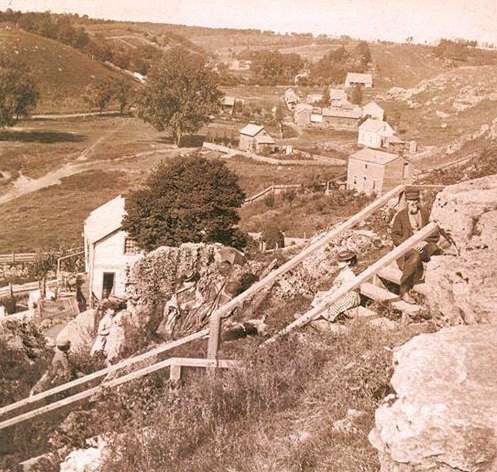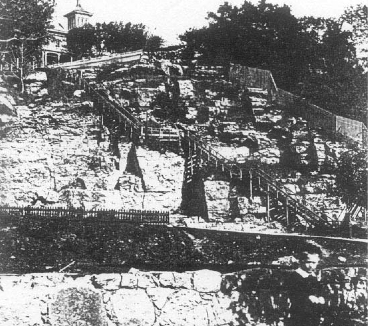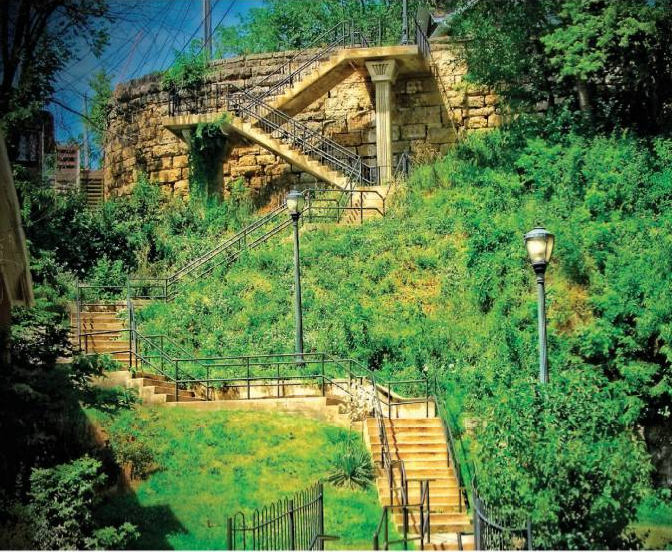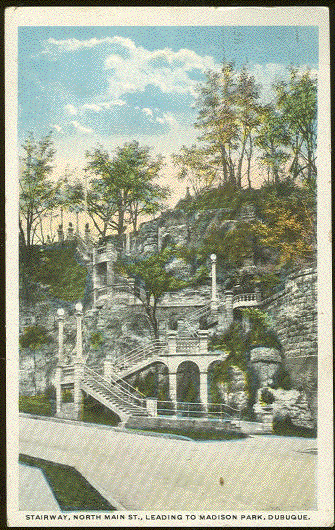Encyclopedia Dubuque
"Encyclopedia Dubuque is the online authority for all things Dubuque, written by the people who know the city best.”
Marshall Cohen—researcher and producer, CNN
Affiliated with the Local History Network of the State Historical Society of Iowa, and the Iowa Museum Association.
MADISON STREET STEPS


MADISON STREET STEPS. Beginning in the 1800s, a set of steep wooden steps allowed homeowners on the bluff a way to reach their houses and visitors a way to reach MADISON PARK. The neighbors, afraid a long detour would be suggested, petitioned the city council in 1918 for replacement steps when the original wooden planks showed signs of deterioration.
The ornate steps constructed at a cost of $2,100, a 100 percent cost overrun, were as much architecture as sidewalk. The eight flights of steps included a spiral staircase with lights on the landings. (1)
In December, 1942 the steps were closed due to their poor condition. The question of whether the City or the park board was responsible for the maintenance of the steps was brought to the council in March, 1943. People had petitioned the council to reopen the steps. In response city manager Albin Anton RHOMBERG had ordered the Park Board to take action under threat of losing money held by the city from the sale of rock at EAGLE POINT.
Park board members, however, responded by saying the Madison Street, West 11th, and West 15th Street steps were "thoroughfares" and not a responsibility of the Par Board. For the Park Board to be made responsible would be unfair. It would interfere with the maintenance of parks and boulevards and did not take into account the history of the board. When the steps were built the Park Board had an annual income of $44,000 and this had been reduced by half. In early years of the GREAT DEPRESSION the board had voluntarily reduced the tax levy for park by about $10,000. With the state adoption of the Beatty-Bennett mandatory tax reduction law, the had to further reduce its tax asking. Park acreage had increased during this time to the point that the money from the sale of rock would only pay part of the renovation costs. (2)
The issue was left unresolved although citizens were found to be crawling over the barricades and continuing to ue the steps. City Solicitor John W. KINTZINGER later reported to the council his opinion that the responsibility rested with the board because the stairway had been given to the board before 1919 by the counci for park purposes. In May the same residents returned to the council which remained convinced, with the legal opinion, that the Park Board had the responsibility. When questioned by the council, Henry HERRMANN stated that the steps had been in use for at least fifty years before the John Vincent RIDER was given to the city for park purposes. Herrmann suggested the city should assume responsibility since estimates had been made that repair costs would be only $4,000. (3)
By 1945 the steps were beginning to show signs of neglect. Deterioration was so advanced by 1956 that the Park Board ordered them closed. Some areas of the steps were demolished, while others were allowed to collapse under their own weight. The only steps left reached the home of Mary Schiesl who had lived in her handsome house at 1752 North Main, on the side of the hill since she was married in 1942.
In 1977, believing that a wealthy person was interested in funding a civic project, the city planner David Dahlquist recreated the design of the steps with a plan that won a national award. Unfortunately, the wealthy donor never materialized. In March 1982, the city council, which had only set aside $40,000 for the project, considered it a waste of taxpayer money to pay $70,000 to build three-flights of plain stairs and a steel railing. Consideration was made just to purchase the Schiesl house and then demolish it and the steps, or assess the home owners $28,000 and build the plain stairs. (4)
In 1977 the proposed reconstruction of the steps for $250,000 was postponed. In its place were six projects: a) reconstruction of the FLORA PARK tennis courts built in 1956, b) completion of the SCHMITT HARBOR boat ramp and the construction of a new one on the west side of CITY ISLAND, c) new sanitary sewers along Kelly Lane and into a subdivision near STEPHEN HEMPSTEAD HIGH SCHOOL, d) roads and improvements at ROOSEVELT PARK, e) roads and improvement at MARSHALL PARK, and f) renovation at the DUBUQUE CITY HALL including perhaps an elevator. (5)
Bidding for the contract to replace the steps was announced in September. The project called for three concrete landings, 190 square feet of sidewalk, and two flights of wooden steps. (6) Actual work began in October 1989. (6)
---
Source:
1. Hendricks, Mike, "The Steps are Getting Mary Down," Telegraph Herald, March 14, 1982, p. 26
2. "Council Tells Board to Make Steps Safe," Telegraph-Herald, March 2, 1943, p. 1
3. "Madison Steps Still Debated," Telegraph-Herald, May 4, 1943, p. 5
4. Hendricks
5. Freund, Bob, "Plans Laid for Every Cent of Building Bonanza," Telegraph Herald, June 21, 1977, p. 5
6. "Notice to Bidders," Telegraph Herald, September 15, 1989, p. 13



